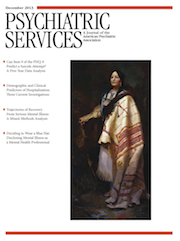Disengagement in a Torture Treatment Program
To the Editor: Treatment programs for torture survivors often provide care without specifying discharge timelines—natural conditions in which to test service engagement. Although needs persist in this group (1), variance in pre- and postmigration stressors (2) suggests that needs are not uniformly chronic. We used survival analysis of data gathered from April 2008 to October 2013 at a New York program to predict disengagement, hypothesizing that posttraumatic stress disorder (PTSD) and associated characteristics would predict later disengagement and that practices accommodating immigrants would predict earlier disengagement.
The consecutive sample of 665 was mostly male (N=397, 60%). The mean±SD age was 33.93±9.65, 509 (77%) reported formal education (mode 12 years), and 249 (37%) spoke functional English. Represented were 75 countries across Africa (N=343, 52%), Asia (N=210, 32%), Europe (N=83, 13%), and the Americas (N=24, 4%). At intake, 515 patients (77%) had unstable immigration status (undocumented or asylum applicant). A total of 555 (83%) met criteria for the U.N. Convention Against Torture, 48 (7%) met World Medical Association criteria only, and 62 (9%) met other criteria. Mean PTSD scores on the Harvard Trauma Questionnaire (HTQ) (3) were 2.59±.62 at intake, and 2.14±.57 at six-month assessment (N=414, 62 %), indicating improved symptoms.
A total of 305 patients (46%) received services from French- or Tibetan-speaking bilingual staff; others received services in English (N=227, 34%) or through telephonic interpreters (N=62, 9%). A total of 556 (84%) used social services, 529 (80%) used mental health care (individual and group therapy and psychopharmacology), and 503 (76%) received legal assistance.
Disengagement was defined as no use of services for six months. Mean days to disengagement was 816.74±25.85; a quarter (27%) did not disengage. Mean days for receipt of social services was 756.04±28.16; mental health care, 616.76±26.61; and legal assistance, 604.79±26.00. Predictors of earlier disengagement were age ≤25 (hazard ratio [HR]=.62; 95% confidence interval [CI]=.49–.79), formal education (HR=.68, CI=.49–.79), European country of origin (HR=.61, CI=.46–.82), functional English (HR=.58, CI=.48–.72), not using bilingual staff (HR=.54, CI=.44–.66), and stable immigration status (HR=.56, CI=.39–.80). Not predicting disengagement were gender, number of persecution types, detention, sexual assault, head injury, and HTQ scores at intake and six months. The most parsimonious Cox regression model predicting earlier disengagement comprised not using bilingual staff (HR=.55, CI=.44–.69) and stable immigration status (HR=.55, CI=.39–.80).
Findings suggest that the needs of half of torture survivors can be reduced to a minimal level within two years. About a quarter may have chronic needs. Disengagement predictors are consistent with research showing education and English ability to be associated with multiple positive outcomes among immigrants (4). Use of bilingual staff predicted later disengagement, countering a hypothesis and suggesting that patients’ preference for services delivered by practitioners who speak their languages (5) prolongs their care. Null trauma findings may seem inconsistent with clinical common sense but reflect research suggesting that many needs of forced migrants are due more to displacement than to trauma severity (2). Programs should emphasize obtaining stable immigration status and redouble English education efforts.
1 : Politically-motivated torture and its survivors: a desk study review of the literature. Torture 15 (2–3):1–111, 2005Google Scholar
2 : Effects of post-migration factors on PTSD outcomes among immigrant survivors of political violence. Journal of Immigrant and Minority Health 15:890–897, 2012Crossref, Google Scholar
3 : The Harvard Trauma Questionnaire: validating a cross-cultural instrument for measuring torture, trauma, and posttraumatic stress disorder in Indochinese refugees. Journal of Nervous and Mental Disease 180:111–116, 1992Crossref, Medline, Google Scholar
4 : Effects of limited English proficiency and physician language on health care comprehension. Journal of General Internal Medicine 20:800–806, 2005Crossref, Medline, Google Scholar
5 : Recognizing and engaging depressed Chinese Americans in treatment in a primary care setting. International Journal of Geriatric Psychiatry 21:819–823, 2006Crossref, Medline, Google Scholar



